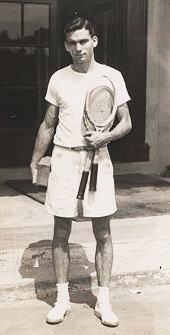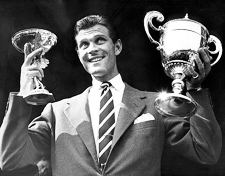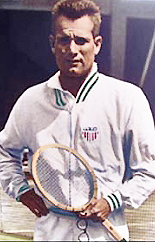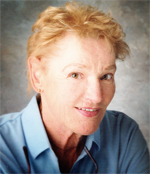Tennis:
A Social Equalizer
Lee Tyler

Ever think of tennis as being a social equalizer?
San Francisco's Tom Brown did. This legendary player and Wimbledon finalist was well known as a spinner of tales relating to travel and his sport.
"I remember waltzing into a big hotel in Bali," he once told me. "I was not staying there. It was too fancy for me, a high rise, with a beautiful swimming pool and golf course, and two clay tennis courts which were very nicely kept.
I tried my 'Do you give private lessons trick?' and it turned out to be a delightful day. The pro, a little fellow about 5'5", didn't play badly at all.
"When we were through he asked me 'Why you hit so many balls to my backhand?' 'Because you run more that way,' I replied, 'and it was a pleasure for me to see you run.' He smiled, and we made a date to play again the next day.
"On that Bali trip, I even became friendly with the golfers on the adjacent course. One of my tennis balls flew over onto the golf course. 'We're missing a tennis ball,' I said to a passing golfer. 'But it's too large to go into one of the holes where you are'. He smiled and said 'These others won't go in either'."
Who would think that one of the most well-known players in the world who won the men's doubles at Wimbledon with Jack Kramer (as well as losing to him in a singles final) could stroll into a luxury hotel, go to the tennis courts and be completely unrecognized?
That wouldn't happen today with Rafael Nadal, now would it?
Back in 1946, when Brown was on the first U.S. Davis Cup team after World War II to challenge cup-holder Australia, he and former U.S champion Frank Parker played two promising juniors "who weren't very good but improved rapidly in a year or two." The boys, aged 11, were Lew Hoad and Ken Rosewall, who became hot singles rivals and also one of the best doubles teams in the world. Together they won Wimbledon, the French, and Australian in 1953 and did it again in 1956 minus the French but plus the U.S. title.

Meanwhile, Lew was on a singles roll - capturing the 1956 titles for the Australian, French and Wimbledon. But not the U.S. - Ken beat him there. Of Lew's play, Don Budge (who played him on Jack Kramer's pro tour) remarked: "When he was on, you might as well have tea or just go home." And a Budge Patty quote (after Lew defeated him at Wimbledon): "If Lew Hoad hit the ball any harder, it would burst into flames." In case you don't recognize the name, Budge had some credibility since he had won both the French and Wimbledon in 1950.
By the way, it's just coincidence - the similarity of the Budge Patty and Don Budge names. Patty's real name is John Edward. "Budge" was a childhood nickname his family called him because it was so hard to get him to budge. His lazy manner developed into one of the most elegant, almost languid, styles seen in tennis.
You've hit a few yourself - those lucky net cord shots that barely plop over onto your opponent's side. When the pros do it, they love making a showy gesture of apology. But for pure honesty, let's hear it for Andy Roddick. He was the semi-final winner at the 2005 Wimbledon over Sweden's Thomas Johansson, thanks to a 4th set tiebreaker netcord, followed by an ace of a clocked speed of 146 mph. Said Andy at his press conference: "The timing couldn't have been better for me. I felt guilty about it for a second, but then I got over it."

All his life he's been known among players as "the old man", "Pappy" or "Dad". At age 38 he was the oldest finalist in the U.S. Singles. At 43 he was the oldest doubles champion at Wimbledon; also the oldest active Davis Cup player. Today, Gardnar Mulloy, 99, of Miami, Florida, is the world's oldest living tennis player of note.
He was recently asked: "What are you doing today?" "Waiting to be 100," he replied. His 100th birthday, November 22, should be a whopper. I'll be sending him a card. How about you?
A few other players of Gar's generation are close behind. Gene Mako, longtime partner of Don Budge, turned 97 on January 24. Louise Brough, holder of 35 grand slam titles, became 90 on March 11. Pancho Segura, he of the wide grin and famous two-fisted forehand, turns 92 on June 20. Vic Seixas, 56 times a winner both nationally and internationally, will hit 90 on August 30.
And don't forget "Dodo" (Dorothy) Bundy Cheney , holder of 400 (really?) gold balls signifying various USTA wins. She'll be 97 on September 1. Tennis players are tough.




